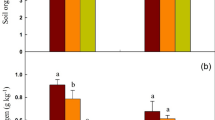Summary
The grain yields in the no-tillage plots were equivalent to those of conventionally plowed treatments. No-tillage treatments had higher organic matter content and, by controlling soil erosion, the silt and clay content than the plowed plots. The water holding capacity and moisture release characteristics of the surface soil horizon were significantly different for the two tillage treatments. A decrase in the maximum soil temperature and favourable moisture regime in the no-tillage plots stimulated biological activity e.g. earthworms. While the fertilizer had no response on the plowed plots, irrigation had a negative effect due probably to severe leaching losses. No-tillage techniques have a potential in achieving continuous cultivation on otherwise highly erodible and shallow tropical soils.
Similar content being viewed by others
References
Brian, R. C., Homes, R. F., Stubbs, J. and Jones, R. L., A new herbicide 1,1′-ethylene-2,2′-dipyridylium dibromide. Nature 181, 446–447 (1958).
Charreau, C., Influences des techniques culturales sur de developpement du ruissellement et de l'érosion en Casamance. Agron. Trop. 24, 836–842 (1969).
Charreau, C. and Fauck, R., Mise au point sur l'utilization agricole des sols de la region de Séfa. (Casamance). Agron. Trop. 25 151–191 (1970).
Charreau, C. and Nicou, R., L'amelioration du profile cultural dans les soils sableux e+ sablo argileux de la zone tropicale seche ouest-africaine et ses incidences agronomiques. Agron. Trop. 26, 903–978 (1971).
Cook, R. L., Turk, L. M. and McColly, H. F., Tillage methods influence crop yields. Soil Sci. Soc. Am. Proc. 17, 410–414 (1953).
Cook, R. L., McColly, H. F., Robertson, L. S. and Hanson, C. M., Save money-water-soil with minimum tillage. Michigan State Univ. Ext. Bull. 352 (1958).
Cook, R. L., Minimum tillage and the environment. Proc. 20th Ann. Meetings of the Agr. Research Inst. Nat. Acad. Sci., 102–112 (1972).
Cronshey, J. F. H., A review of experimental work with Diquat and related compounds. Weed Research 1, 1, 68 (1961).
Fournier, F., Research on soil erosion in Africa. African Soils 12, 53–96 (1967).
Hood, A. E. M., Jameson, H. R. and Cotterell, R., Destruction of pastures by paraquat as a substitute for plowing. Nature 197, 748 (1963).
Jeater, R. S. L. and McIlvenny, H. C., Direct-drilling of cereals after use of paraquat. Weed Research 5, 311–318 (1965).
Kannegieter, A., Zero cultivation and other methods of reclaiming Pueraria fallowed land for food crop cultivation in the Forest Zone of Ghana. Trop. Agr. 123, 1–2 (1967).
Kannegieter, A., The combination of short term Pueraria fallow zero cultivation and fertilizer application: Its effect on a following maize crop. Trop. Agr. 125, 77–89 (1969).
Kuipers, H., Historical notes on the zero-tillage concept. Neth. J. Agr. Sci. 18, 219–224 (1970).
Lal, R., Effects of seed bed preparation and time of planting of maize (Zea mays) in Western Nigeria. Exp. Agr. 9, 303–313 (1973).
Macartney, J. C., Northwood, P. J., Dagg, M. and Dawson, R., The effect of different cultivation techniques on soil moisture conservation and the establishment and yield of maize at Kongwa, Central Tanzania. Trop. Agr. 48, 9–23 (1971).
Muller, J. and Bilderling, G.De., Les methodes culturales indigenes sur les sols equatoriaux de plateau. I.N.E.A.C. Belg. Bull. Inform. 2, 21–30 (1953).
Northwood, P. J. and Macartney, J. C., The effect of different amounts of cultivation on the growth of maize on some soil types in Tanzania. Trop. Agr. 48, 25–33 (1971).
Pereira, H. C. and Jones, P. A., A tillage study in Kenya II. The effects of tillage practices on structure of soil. Empire J. Exp. Agr. 23, 323–331 (1954).
Pereira, H. C., Wood, R. A., Brzostowki, H. W. and Hosegood, P. H., Water conservation by fallowing in semi-arid tropical East Africa. Empire J. Exp. Agr. 26, 213–228 (1958).
Russell E. W. and Keen B. A., Studies in soil cultivation X. The results of six year cultivation experiment. J. Agr. Sci. 31, 326–347.
Author information
Authors and Affiliations
Rights and permissions
About this article
Cite this article
Lal, R. No-tillage effects on soil properties and maize (Zea mays L.) production in Western Nigeria. Plant Soil 40, 321–331 (1974). https://doi.org/10.1007/BF00011514
Received:
Issue Date:
DOI: https://doi.org/10.1007/BF00011514




